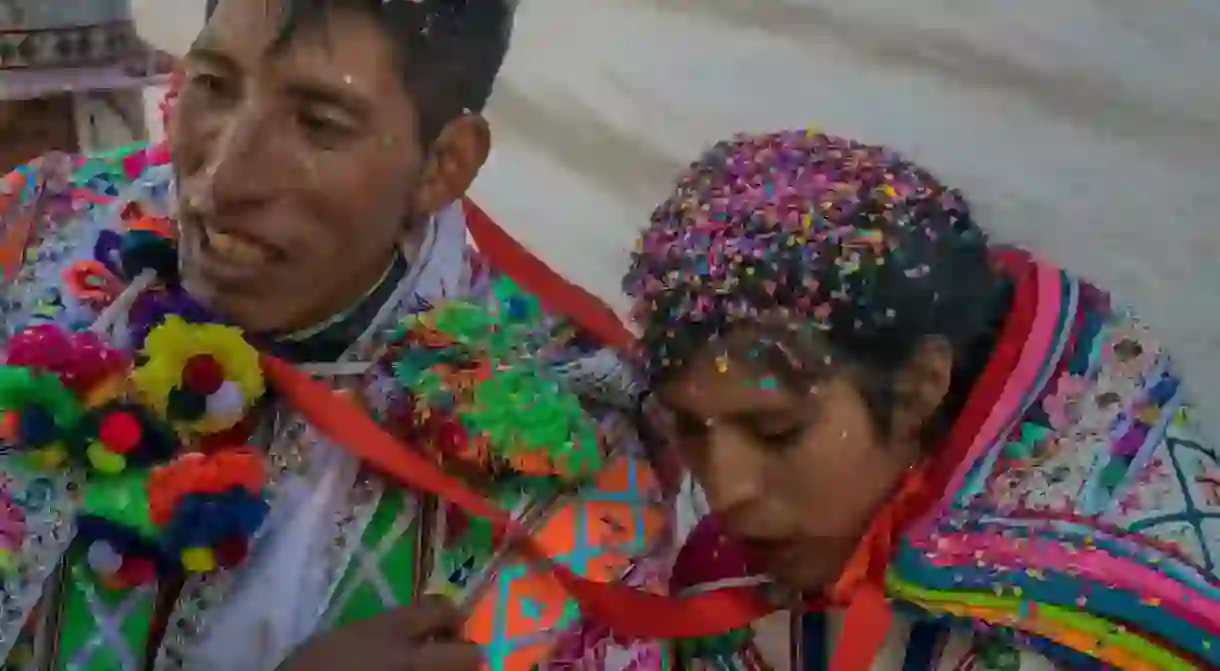A Peek Inside a Traditional Andean Wedding Ceremony

In a traditional Andean wedding ceremony, thousands of locals celebrate a couple’s unification in the presence of their most revered goddess: Pachamama (Mother Earth). Culture Trip joined the 1,500 wedding guests to experience first-hand how local Peruvians still practice these ancient customs – many of which pre-date the Incas – to this day.
In the high mountain town of Pacchanta, frantic preparations for the first wedding of the year have been underway for the past three days. The bride and groom’s family have been working day and night putting up decorations, preparing food, and sewing colorful hems and shiny sequins to the couple’s elaborate wedding outfits.

According to tradition, the groom’s outfit includes an elaborate poncho decorated with flowers and animals (in honor of Pachamama), a heavily-sequined chullo (a traditional Andean hat with earflaps), and a large Montera hat decorated with white beaded straps, green and red ribbons, and colorful woollen pom poms.

The bride wears a matching Montera hat, a sequined Jobona (a traditional wool jacket decorated with patterns depicting scenes from nature), and – the showstopper – a beautifully detailed pollera skirt. Women wear polleras every day, but for special occasions they’re given a bit of a makeover. While an everyday pollera will only have a single colorful hem running along the bottom, wedding skirts are far more elaborately decorated. The bride will also wear several skirts (sometimes up to 10!) to give it more volume.

Guests, too, dress up for the occasion by adding more color and glitz to their traditional Andean skirts and hats. But, like any wedding, they must never outshine the bride and groom.

A marriage between two people in Andean culture is affirmed by the unification of the couple with Pachamama, or the Earth Mother. For this reason, the reception – like most Andean celebrations – takes place outside, in the presence of the sacred Apus (mountain Gods) and every other natural being that Pachamama embodies. After a quick, private civil ceremony in the nearby town of Tinki, the newlyweds (accompanied by hundreds of family, friends, and neighbors from nearby villages) arrive to the sound of drums and trumpets. The bride and groom are each welcomed by a mug of Chicha de Jora, a fermented corn drink invented by the Incas.


Once they arrive at the reception, the married couple take a seat along with their parents and close friends at the wedding top table. Here they eat not one, but two traditional Andean feasts: one cooked by the bride’s family, and the other by the groom’s. The families get to work preparing the home-cooked feast for over 1,500 attendees while the guests make their way across the mountain plains to the reception. Everyone perches themselves on the rocks that surround the field until the food is ready, and the family forms lines to distribute the meals. Each person receives a box of alpaca meat, potatoes, choclo (boiled corn), and rice.




Guests also customarily give the spouses a gift that will help them start off their newly joined life. Once the meal is finished, everyone queues up on either side of a long red ribbon, which is wrapped around the couple’s neck as they sit at the wedding top table. Once friends and family reach the newlyweds, they shower the two with confetti and bequeath their offerings of money, fizzy drinks, corn, and potatoes. The bride kisses each present and extends a few handfuls of corn in return to show their gratitude. Meanwhile, the closest family members form a nearby pile of large gifts – including beds, cookers, and wardrobes – to fill the new pair’s family home.




Over three hours later, the last few well-wishers give their offerings. This means only one thing: it’s time to party. The women take to the dancefloor first, forming a big circle and twirling their skirts to the live music of a folk band. Soon after, the men join in as well. They take the hands of the women, and each pair dances in the middle of the circle. Locals say these dances are an important time for both sides of the family to bond.



Much singing, dancing, and chicha drinking continues into the early hours of the morning, even as temperatures dip below zero. Although the families here no longer party for a week straight as their Incan ancestors did, Andean wedding ceremonies like this are known to last for at least several days. It is, after all, a celebration of the two things they value most: family and Mother Earth.













